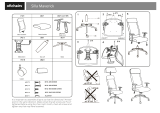
3.0 Warnings for Components and Options
• If you use parts or make changes not authorized by
Sunrise it may create a safety hazard and will void the
warranty.
1.
2.
1. Standard foam cushions and other body supports are
not designed for the relief of pressure.
2. If you suffer from pressure sores, or if you are at risk
that they will occur, you may need a special seating
system or a device that will help control your posture.
• Consult your Healthcare Professional to find out if you
need such a device for your comfort and health.
2.
3.
If fasteners become loose, tighten them immediately.
Do not over- or under-tightened fasteners as this can
cause damage to your system or it’s components.
4. Do not reuse fasteners.
3.4 Footplate and footrests
•
1. At the lowest point, footrests should be at least
2" (51 mm) off the ground. If set too LOW, they
may “hang up” on obstacles you can expect to find
in normal use. This may cause the system to stop
suddenly and tip forward.
2. To avoid a trip or fall when you transfer:
•Make sure your feet do not “hang up” or get caught
in the space between the footrests.
Avoid putting weight on the footrests, as the
system
may tip forward.
• Remove or swing the footrests out of the way, if
possible.
3. The footrest should always be in the down position
when operating the system.
4. Never lift this system by the footrests. Footrests
detach and will not bear the weight of this system. Lift
this system only by non-detachable parts of the main
frame.
1.
2.
3.
Make sure the rider does not slide down in the
seating system seat. If this occurs, the rider may suffer
chest compression or suffocate due to pressure from
the belts.
The belts must be snug, but must not be so tight that
they interfere with breathing. You should be able to
slide your open hand, flat, between the belt and the
rider.
A pelvic wedge or a similar device can help keep the
rider from sliding down in the seat. Consult with the
rider’s doctor, nurse or therapist to find out if the
rider needs such a device.
4. Use positioning belts only with a rider who can
cooperate. Make sure the rider or attendant can
easily remove the belts in case of emergency.
5. NEVER use positioning belts:
a. As a patient restraint. A restraint requires a
doctor’s order.
b. On a rider who is comatose or agitated.
c. As a motor vehicle restraint. In an accident or
sudden stop the rider may be thrown from the
system. Seating system seat belts will not prevent
this, and further injury may result from the belts or
straps.
If you fail to heed these warnings, damage to your
system, a fall, tip-over or loss of control may occur
and cause severe injury to the rider or others.
3.6 Push handles
1. Push handles provide secure points for an attendant
to propel and control the system. This helps to
prevent a fall or tip-over.
2. Check to make sure push handle grips will not rotate
or slip off.
3.7 Seating systems
1. Use of a seating system not approved by Sunrise may
affect or interfere with other parts of the system.
2. Never
change the seating system unless you consult
your
authorized dealer first.
3. Never raise your seating system to a height of more
than 19" (482mm) (measuring from the front of the
seat pan to the floor) with all actuators in their home
position.
WARNING!
3.1 Armrests
WARNING!
Armrests will not bear the weight of this system.
Never
lift this system by its armrests. They may
come
loose
or break.
When transferring the user in or out of the seating
system never use the armrest as a means of support.
3.2 Cushions
WARNING!
3.3 Fasteners
DANGER!
Many of the screws, bolts and nuts on this
system are special high-strength fasteners. Use
of improper fasteners may cause your system to fail.
1. Only use fasteners provided by Sunrise.
DANGER!
3.5 Positioning belts
DANGER!
The positioning belt is predominately used to support
your posture. It can also be used to limit slipping and/or
sliding that you might experience when the system is in
motion. The positioning belt is not a transit rated safety
belt and should not be used in the place of a seat belt
while being transported in a motor vehicle. Improper
use of Positioning belts may cause severe injury or
death. If you use a positioning belt, be sure to follow the
recommendations in this section:
DANGER!
DANGER!
3.























